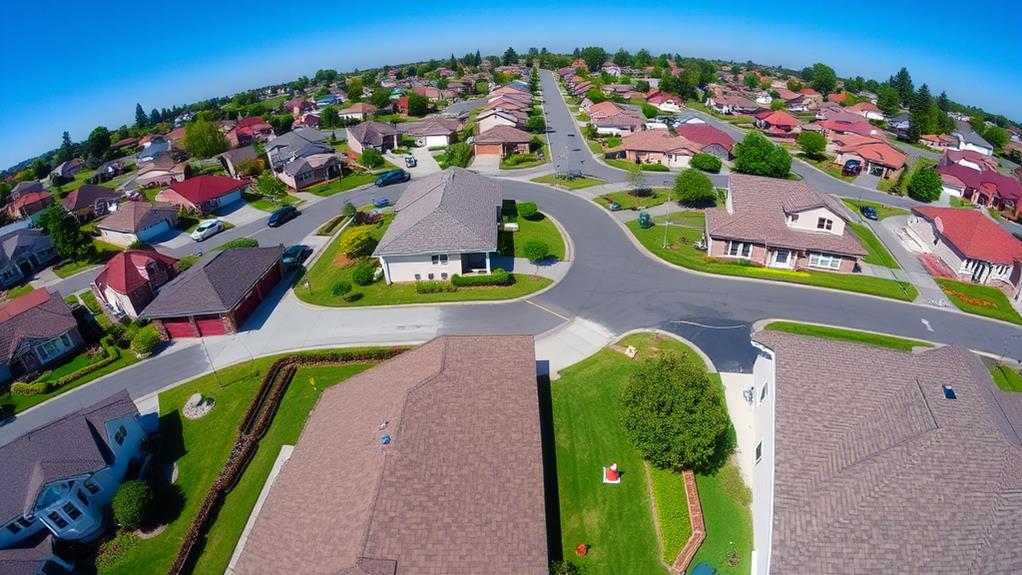Obtaining a residential roofing permit is an essential component in adhering to local building codes and ensuring the integrity of construction projects. It mandates an understanding of regulations and methodical preparation, involving exhaustive documentation, cost estimation, and the use of municipal resources for application submission. Common pitfalls, such as inadequate documentation and neglecting zoning laws, can lead to costly delays and fines. However, mastering the permit process can streamline project timelines, enhance property value, and bolster community safety. Engaging with this regulatory framework not only fosters compliance but also positions you for successful project execution and long-term property benefits.
Roofing Highlights
- Residential roofing permits ensure compliance with local building codes and regulations.
- Thorough documentation and checking zoning regulations can prevent common permit application mistakes.
- The permit application process typically takes 2 to 4 weeks but can vary by jurisdiction.
- Online submission systems streamline the application process and track progress efficiently.
- Proper permits enhance property value and signal quality adherence to potential buyers.
Understanding Residential Roofing Permits

Traversing the intricacies of residential roofing permits requires a thorough understanding of their critical role in ensuring compliance with local building codes, fostering structural integrity, and safeguarding homeowners' investments. It's beneficial to work with a company that provides roof repair and replacement services, as they can guide you through this process.
Streamlining the permit application process involves familiarizing oneself with relevant documentation and criteria, thereby mitigating risks of delays or rejections. Additionally, being aware of common pitfalls such as incomplete applications or failing to adhere to zoning regulations is essential to prevent costly setbacks and facilitate smooth project execution.
Importance of Proper Documentation
Proper documentation plays a critical role in the domain of residential roofing permits, ensuring seamless compliance with local building codes and regulations. A meticulously assembled set of documents not only facilitates the approval process but also instills trust and confidence among stakeholders, including homeowners, contractors, and regulatory bodies. Thorough documentation exhibits a commitment to quality and adherence to legal standards, reflecting a structured plan that aligns with community safety and integrity.
For residential roofing projects, essential documentation includes detailed plans, material specifications, structural calculations, and proof of contractors' licensing and insurance. These documents serve as a blueprint for safe construction, reducing the likelihood of errors and potential liabilities. Additionally, comprehensive documentation supports chronological project tracking, providing a reliable reference for progress assessment and any required modifications. This transparency fosters community connection, as all parties involved share a common understanding of the project's objectives and boundaries.
Furthermore, maintaining accurate records of permits and inspections is pivotal for future property transactions. Well-documented roofing permits enable smoother changes in ownership and potentially enhance property values. Ultimately, proper documentation cultivates a culture of accountability and cooperation, reinforcing a sense of belonging within the broader community.
Permit Application Process Simplified
Understanding the permit application process is an essential step in managing residential roofing projects successfully. Navigating this process efficiently ensures compliance with local regulations and contributes to the project's smooth progression. Begin by consulting your local building department to obtain detailed requirements and forms tailored to residential roofing permits. Each jurisdiction may have distinct prerequisites, so engaging directly with officials establishes a solid foundation.
Prepare all necessary documentation meticulously, including the prescribed forms, site plans, and comprehensive project descriptions. Applicants must provide an estimation of costs, ensuring financial elements align with anticipated expenditures. Submit this completed package to the governing agency for assessment. Promptly responding to any requests for additional information can prevent unnecessary delays. Harnessing technology, many jurisdictions now offer online application systems, streamlining document submission and tracking progress electronically.
Participating in this communal process fosters a sense of belonging and accountability, reinforcing shared standards within the community. As part of a larger network of homeowners, contractors, and officials, you contribute to a collaborative effort that maintains safety and quality. Ultimately, understanding this streamlined application process not only adheres to local mandates but fortifies ethical practices and holistic project success.
Common Permit Mistakes
Among the most frequent missteps in acquiring residential roofing permits is inadequate documentation. When homeowners or contractors fail to furnish all necessary documents, it can lead to frustrating delays—a situation no community-focused individual desires. Variance in documentation requirements across municipalities intensifies the predicament, as one might anticipate swift approval only to discover missing elements in the application.
Another prevalent mistake is neglecting to verify zoning regulations before advancing with the permit process. Communities often have distinct zoning bylaws that might restrict specific roofing modifications. The oversight of not checking these regulations can result in non-compliance notices and possibly costly project modifications. Proper due diligence and thorough research are indispensable for a seamless experience.
In addition, many applicants mistakenly presume that minor roof repairs do not necessitate permits. In reality, even modest modifications can affect structural integrity or aesthetic standards, warranting official approval. Disregarding such requirements not only defers progress but can also lead to fines or reputation damage within one's community.
Ultimately, understanding common permit mistakes helps homeowners and contractors prepare more effectively, ensuring that projects not only meet legal stipulations but also contribute positively to neighborhood harmony and standards.
Benefits

Securing residential roofing permits offers a multitude of advantages, remarkably streamlining the project approval process, which guarantees timely commencement and completion of construction activities.
Permits help facilitate better project management, ensuring that a skilled residential roofing contractor oversees the compliance of essential construction elements, including roofing, siding, and gutters. Compliance with the latest safety regulations is enhanced by the meticulous inspection and approval protocols inherent in the permitting process, thereby minimizing potential risks associated with roofing projects.
Additionally, homes with permits are often perceived as having increased property value, as they signal to future buyers a commitment to quality and adherence to local building standards.
Streamlined Project Approval
Streamlining the project approval process for residential roofing permits provides significant advantages, both for contractors and homeowners. By optimizing this procedure, local authorities can alleviate bottlenecks, facilitating quicker project initiation and completion. This efficiency fosters a smoother collaboration between contractors and property owners, fostering a sense of partnership that bolsters community development. A streamlined process guarantees contractors can allocate resources more effectively, avoiding costly delays and scheduling disruptions.
Homeowners stand to benefit from reduced waiting times, allowing them to advance their home improvement projects with confidence and in a timely manner. This expedited approval process also enhances homeowners' ability to respond to urgent needs, such as repairs following severe weather conditions, consequently preserving the integrity and safety of their residences. Additionally, it cultivates a neighbourhood-wide atmosphere of trust and shared progress, where homeowners feel supported by efficient municipal systems.
The innovative use of digital platforms and pre-approved templates can further expedite the approval process. These measures enhance transparency and predictability in project management, giving stakeholders a clear understanding of timelines and required documentation. This level of precision and clarity fosters loyalty and strengthens the collective investment in sustainable community growth.
Enhanced Safety Compliance
Implementing enhanced safety compliance standards for residential roofing permits yields numerous benefits that extend beyond mere regulatory adherence. Ensuring strict safety protocols cultivates a secure environment not only for roofing professionals who are directly engaged in the installation process, but also for homeowners and occupants who find comfort in knowing their residences are constructed under ideal safety measures. Enhanced compliance minimizes risk, mitigating potential hazards such as falls or structural failures, which might otherwise jeopardize physical safety.
Moreover, rigorous safety standards instill a culture of trust and reliability within the community. Homeowners are more likely to engage in roofing projects, understanding that stringent inspections and codes are designed to safeguard their investments and personal well-being. Consequently, this creates a collective mindset where safety is prioritized, fostering a sense of unity amongst community members who value diligence and care in residential roofing undertakings.
These all-inclusive safety measures lead to increased professionalism within the roofing industry itself. Companies that demonstrate adherence to high safety standards not only build a reputation for excellence but also attract skilled laborers committed to maintaining such standards, ultimately contributing to sustainable, safe, and cohesive neighborhood development.
Increased Property Value
Homeowners often find that compliance with enhanced safety standards directly contributes to increased property value. By investing in quality roofing systems that meet stringent regulatory requirements, not only are they protecting their homes from potential structural damage, but they are also aligning themselves with market expectations. Many potential buyers today are especially keen on homes that demonstrate a strong adherence to modern building codes, as this indicates a commitment to long-term durability and homeowner responsibility.
Furthermore, roofing permits, often overlooked, play a pivotal role in this process. Acquiring these permits means that the roof has been inspected by qualified professionals, ensuring that it meets all necessary municipal and regional specifications. This assurance is a significant value proposition to potential buyers, providing peace of mind regarding the future reliability and safety of the roof.
The increase in property value can also be attributed to the aesthetic improvements and energy efficiencies afforded by upgraded roofing. Enhanced insulation, for example, not only reduces energy costs but also contributes to a more environmentally friendly home, a feature valued by the environmentally conscious, community-driven buyer. Thus, the value added by compliant roofing systems can permeate multifaceted areas of property consideration.
Permit Application Timeframe

When approaching the permit application timeframe for residential roofing projects, it is essential for applicants to be well-informed about both the average processing time and the potential for common delays that might impede progress. Understanding these temporal factors can aid in formulating efficient submission strategies that align with regulatory expectations, thereby reducing the likelihood of setbacks. Below is a table highlighting key considerations related to processing timelines and typical hindrances encountered:
| Consideration | Details |
|---|---|
| Processing Time Expectations | Typical processing period ranges from 2 to 4 weeks. |
| Common Delays Encountered | Incomplete documentation and peak construction periods. |
| Efficient Submission Strategies | Early submission and thorough documentation check. |
| Regulatory Dependencies | Varies by jurisdiction and specific project requirements. |
Processing Time Expectations
Typically, understanding the processing time expectations for residential roofing permits is essential for efficient project planning. Traversing these timelines allows homeowners and contractors to synchronize their efforts with local regulatory bodies, fostering an environment conducive to minimizing unforeseen delays. Generally, the timeframe can vary drastically depending on jurisdiction, ranging from just a few days to several weeks. This variance is influenced by factors such as the complexity of the roofing project, the demand on the permitting office, and adherence to local zoning regulations.
Most municipalities offer detailed information about their processing timelines through various channels, including online portals or by visiting their offices. This information is often accompanied by guidelines that outline specific documentation required for permit issuance. Preparing an all-encompassing application in accordance with these requirements is pivotal in facilitating a smooth approval process. For those who desire a more seamless navigation through the bureaucratic procedures, consulting with seasoned professionals in the roofing industry is advisable, as they possess nuanced insights into local processes.
Ultimately, familiarizing oneself with processing time expectations not only fortifies project management but also engenders a sense of community participation by aligning with local governance practices and contributing to safety and regulatory compliance.
Common Delays Encountered
Maneuvering the process of obtaining a residential roofing permit can sometimes be impeded by common delays that affect the overall application timeframe. Initially, the intricacies of local regulations can bewilder applicants; discrepancies between submitted documents and municipal codes may arise, necessitating revisions that extend the timeframe.
Incomplete applications are a frequent stumbling block—every detail, from zoning requirements to structural diagrams, must be meticulously fulfilled to avert needless prolongation.
Another frequent delay stems from seasonal fluctuations in permit applications. Decreasing temperatures prompt a surge in requests as property owners seek roofing projects before adverse weather sets in, consequently overwhelming permitting offices and extending processing times.
Additionally, personnel shortages within city departments can exacerbate this situation; when reviewing capacity is diminished, the queue of pending applications inevitably lengthens.
It is also pertinent to recognize external factors, such as technological system upgrades in municipal offices, which occasionally impede the digital processing of applications. Even more tangibly, the coordination with neighborhood associations for approval can introduce unexpected hindrances.
Traversing these bureaucratic landscapes demands vigilance and patience, yet understanding these common hurdles fosters a sense of belonging and prepares applicants to face them with informed anticipation.
Efficient Submission Strategies
Traversing the complexities of the permit application process with efficiency requires a strategic approach aimed at minimizing delays. Initiating this journey necessitates a comprehensive understanding of local regulations and preparation of all required documentation in advance.
Deploying a roadmap that encompasses foresight can substantially smoothen the path towards obtaining your residential roofing permit. The articulation of this roadmap must integrate timelines aligned with municipal planning department schedules, which are crucial in preventing bottlenecks that might otherwise disrupt the project's momentum.
To underscore efficiency, it is prudent to engage with either specialists in permit acquisition or local authorities early in your project. This engagement cultivates insightful dialogue, fostering a reciprocal relationship, which is intrinsic to the assimilation of nuances inherent to jurisdictional requirements.
A meticulous review of application materials guarantees completeness and accuracy, forestalling common errors that may result in prolonged approval processes. Prioritizing electronic submissions, where applicable, can further expediate interactions and reduce potential backlogs that physical submissions might encounter.
Ultimately, an adherence to these strategies intertwines your project smoothly with local processes, ensuring not only compliance but also alignment with shared community standards for maintaining safety and integrity in residential structures.
Connect With Us
Ready to start your residential roofing project? Whether you're considering roofing services for a new installation or a repair in the Denver metro area, our expert team is here to help.
Don't wait any longer to achieve the home of your dreams. Reach out to our expert team today for guidance on roofing permits and more! Call us now at (303) 306-8384. Your dream roof is just a phone call away!
Roofing FAQ
What Specific Roofing Materials Require a Permit?
In addressing material-specific permits, it is essential to recognize that certain roofing materials such as metal, slate, or clay tiles potentially require permits due to their structural implications and adherence to local building codes, ensuring community safety.
Are There Exceptions for Historical or Landmark Properties?
Regarding exceptions for historical or landmark properties, regulations may indeed vary, often allowing more flexibility in preserving architectural integrity. It is critical to consult local guidelines and experts to guarantee compliance while honoring heritage preservation objectives.
Do Roofing Permits Vary by County Within the State?
Regulations, such as permit requirements, often vary by county within the same state. It is prudent to consult local authorities to guarantee compliance with regional standards, fostering a sense of community and responsibility among residents and policymakers.
Are There Penalties for Not Obtaining a Permit?
Failure to obtain necessary permits often results in penalties, including fines, project delays, or legal actions. Ensuring compliance with local regulations fosters a sense of belonging within responsible communities and supports adherence to safety standards.
Can Homeowners Apply for a Roofing Permit Themselves?
Homeowners often inquire if they can independently apply for necessary permits. Indeed, homeowners can typically apply for permits themselves, fostering a sense of empowerment and ensuring their participation in the community's compliance with local regulations.




